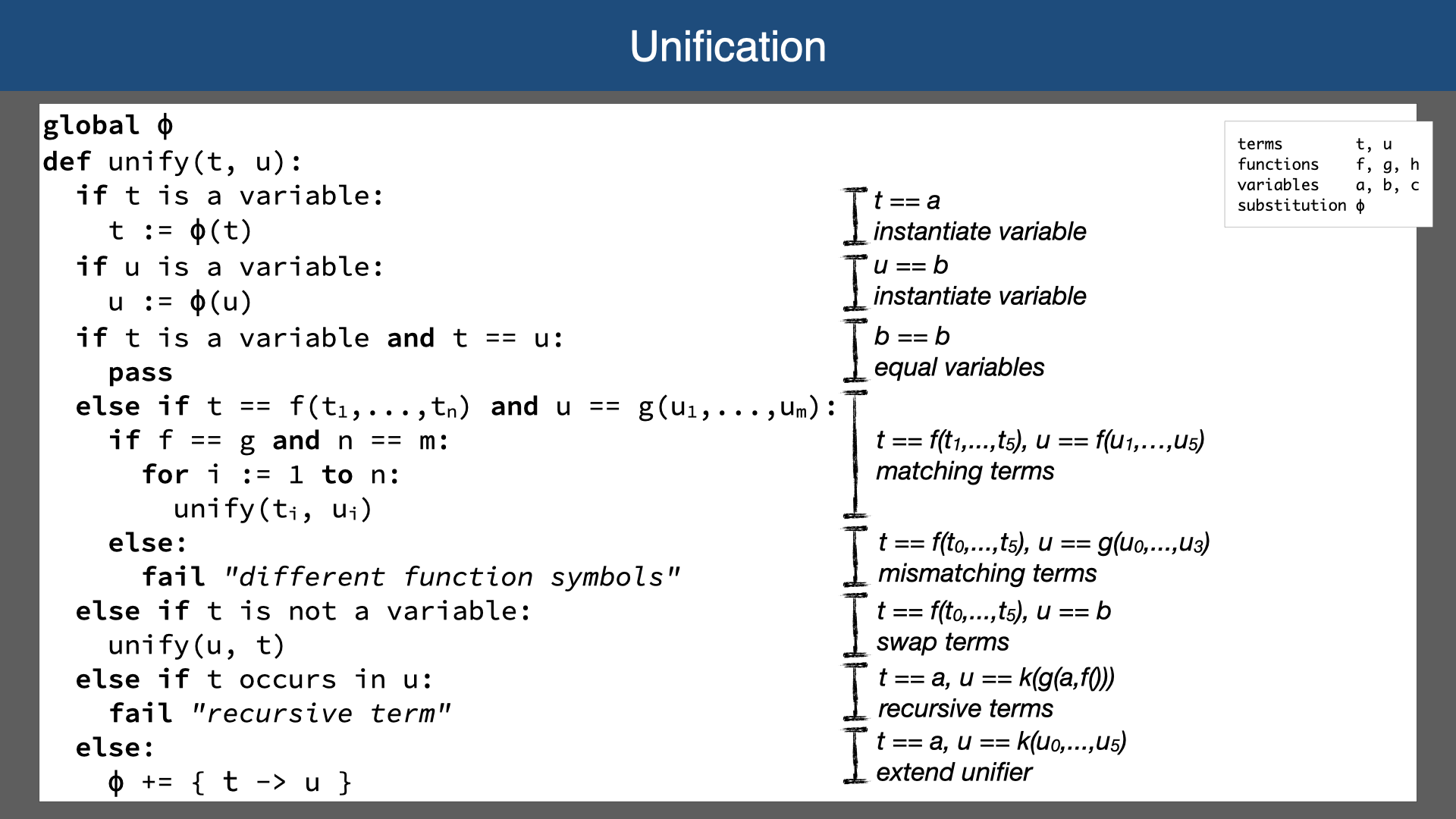
Lecture 6: Constraint Semantics and Constraint Resolution
Eelco Visser
Lecture
| PDF
September 30, 2021
In this lecture we study the semantics and implementation of type checking with constraints. We study the declarative semantics of constraints by means of constraint satisfaction: given a model (solution), does is the constraint satisfied under that model? And we study the implementation of constraint solvers as a rewrite system that simplifies constraints to basic unification, scope graph, and name resolution constraints. Finally, we study unification, its properties, a naive algorithm, and efficient implementation using union-find.
The PDF of the slides with builds are useful for the union-find section.
Slides
References
-
Knowing when to ask: sound scheduling of name resolution in type checkers derived from declarative specificationsThere is a large gap between the specification of type systems and the implementation of their type checkers, which impedes reasoning about the soundness of the type checker with respect to the specification. A vision to close this gap is to automatically obtain type checkers from declarative programming language specifications. This moves the burden of proving correctness from a case-by-case basis for concrete languages to a single correctness proof for the specification language. This vision is obstructed by an aspect common to all programming languages: name resolution. Naming and scoping are pervasive and complex aspects of the static semantics of programming languages. Implementations of type checkers for languages with name binding features such as modules, imports, classes, and inheritance interleave collection of binding information (i.e., declarations, scoping structure, and imports) and querying that information. This requires scheduling those two aspects in such a way that query answers are stable—i.e., they are computed only after all relevant binding structure has been collected. Type checkers for concrete languages accomplish stability using language-specific knowledge about the type system. In this paper we give a language-independent characterization of necessary and sufficient conditions to guarantee stability of name and type queries during type checking in terms of critical edges in an incomplete scope graph. We use critical edges to give a formal small-step operational semantics to a declarative specification language for type systems, that achieves soundness by delaying queries that may depend on missing information. This yields type checkers for the specified languages that are sound by construction—i.e., they schedule queries so that the answers are stable, and only accept programs that are name- and type-correct according to the declarative language specification. We implement this approach, and evaluate it against specifications of a small module and record language, as well as subsets of Java and Scala.
-
Scope graphs are a promising generic framework to model the binding structures of programming languages, bridging formalization and implementation, supporting the definition of type checkers and the automation of type safety proofs. However, previous work on scope graphs has been limited to simple, nominal type systems. In this paper, we show that viewing scopes as types enables us to model the internal structure of types in a range of non-simple type systems (including structural records and generic classes) using the generic representation of scopes. Further, we show that relations between such types can be expressed in terms of generalized scope graph queries. We extend scope graphs with scoped relations and queries. We introduce Statix, a new domain-specific meta-language for the specification of static semantics, based on scope graphs and constraints. We evaluate the scopes as types approach and the Statix design in case studies of the simply-typed lambda calculus with records, System F, and Featherweight Generic Java.
-
In previous work, we introduced scope graphs as a formalism for describing program binding structure and performing name resolution in an AST-independent way. In this paper, we show how to use scope graphs to build static semantic analyzers. We use constraints extracted from the AST to specify facts about binding, typing, and initialization. We treat name and type resolution as separate building blocks, but our approach can handle language constructs -- such as record field access -- for which binding and typing are mutually dependent. We also refine and extend our previous scope graph theory to address practical concerns including ambiguity checking and support for a wider range of scope relationships. We describe the details of constraint generation for a model language that illustrates many of the interesting static analysis issues associated with modules and records.
-
We describe a language-independent theory for name binding and resolution, suitable for programming languages with complex scoping rules including both lexical scoping and modules. We formulate name resolution as a two-stage problem. First a language-independent scope graph is constructed using language-specific rules from an abstract syntax tree. Then references in the scope graph are resolved to corresponding declarations using a language-independent resolution process. We introduce a resolution calculus as a concise, declarative, and languageindependent specification of name resolution. We develop a resolution algorithm that is sound and complete with respect to the calculus. Based on the resolution calculus we develop language-independent definitions of α-equivalence and rename refactoring. We illustrate the approach using a small example language with modules. In addition, we show how our approach provides a model for a range of name binding patterns in existing languages.
-